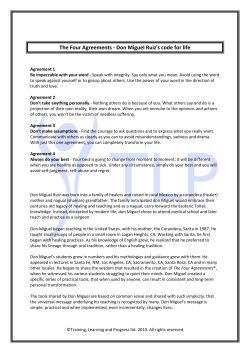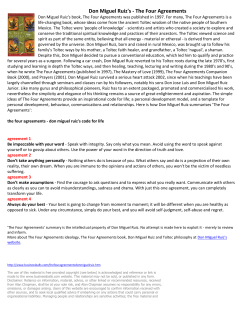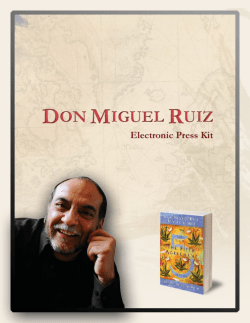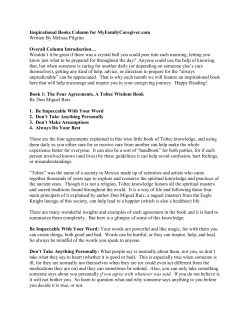
How to Manage a Small/Medium-Sized Law Firm UIA Training Course
Your Name: Monday 13th and Tuesday 14th May 2013 UIA Training Course Paris How to Manage a Small/Medium-Sized Law Firm Handout By José Antônio Miguel Neto & Pippa Blakemore Managing Law Firms & Legal Marketing th th 13 and 14 May 2013 Action Plan - Monday 13 May 2013 Action 2 José Antônio Miguel Neto & Pippa Blakemore Managing Law Firms & Legal Marketing th th 13 and 14 May 2013 Action Plan - Tuesday 14 May 2013 Action 3 José Antônio Miguel Neto & Pippa Blakemore Managing Law Firms & Legal Marketing th th 13 and 14 May 2013 Day 1 – How to Manage a Small/Medium-Sized Law Firm Challenges you face – list all 4 José Antônio Miguel Neto & Pippa Blakemore Managing Law Firms & Legal Marketing th th 13 and 14 May 2013 Objectives Your firm Vision (get fit) Goals SMART targets (Run a 4 minute mile by July 1st 2013) Methods (Go to gym 3 times a week) 5 José Antônio Miguel Neto & Pippa Blakemore Managing Law Firms & Legal Marketing th th 13 and 14 May 2013 The Legal Manager Qualities Firm 1 – 10 1 = lowest 10 = highest Personal Action to take 1- 10 1 = lowest 10 = highest 1. Building strong teams 2. Effective decisionmaking 3. Chairing and participating in productive management meetings 4. Project management 5. Appraisals which motivate 6. Giving productive feedback 7. Communication 8. Delegation, supervision, motivation 9. Managing poor performance 10. Managing difficult people 6 José Antônio Miguel Neto & Pippa Blakemore Managing Law Firms & Legal Marketing th th 13 and 14 May 2013 11. Conflict resolution 7 José Antônio Miguel Neto & Pippa Blakemore Managing Law Firms & Legal Marketing th th 13 and 14 May 2013 Flow chart symbols Source: Improving Business Processes – Harvard Business Review Press, 2010, page 29 Symbol Example Take order Meaning An activity that a person or technology performs Box Diamond Arrow A review or decision that a person or technology must conduct or make The direction of the work flow: arrows can appear between any flowchart symbols Filing or storage of materials or information Triangle 8 José Antônio Miguel Neto & Pippa Blakemore Managing Law Firms & Legal Marketing th th 13 and 14 May 2013 How to standardise activities in your firm 1. Think of one activity you would like to standardise 2. List all the stages in this activity + time taken + who does it Activity to be standardised: Steps – who has input at each step Time Who Responsible 1. 2. 3. 4. 5. 6. 7. 8. 3. Now make a flowchart for this in the space below 9 José Antônio Miguel Neto & Pippa Blakemore Managing Law Firms & Legal Marketing th th 13 and 14 May 2013 Manuals 1. Complete table below 2. Discuss on your table 3. Add to table below 4. Add to your Action Plan What manuals do you have? What should you have? What should be included? How can you ensure people use them? 10 José Antônio Miguel Neto & Pippa Blakemore Managing Law Firms & Legal Marketing th th 13 and 14 May 2013 Overcoming the management and entrepreneurial challenges Write down here one way in which you have gone “more than the extra mile”. I have gone “more than the extra mile” by... Discuss this on your table and add the ways in which others have gone the extra mile that your clients might like: 1. 2. 3. 4. 5. 11 José Antônio Miguel Neto & Pippa Blakemore Managing Law Firms & Legal Marketing th th 13 and 14 May 2013 Is your firm or legal department “Old Normal” or “New Normal”? Information Old normal New normal Filing cabinet “Cloud” Action to take location First instinct How often is Make things more Make things complex more simple Occasionally Systematically National Global and law relevant to clients? Geography online Orientation Win-lost Win-win Cost Expensive Reasonable, consistent with other inputs Effort Maximum – any less is unethical Appropriate focus on outcomes, not inputs Hours Outcomes Most common metric Organisational assessment Hierarchy form Distributed authority based on accountability 12 José Antônio Miguel Neto & Pippa Blakemore Managing Law Firms & Legal Marketing th th 13 and 14 May 2013 Rare and high Old normal New normal “Ethical” “Operationally compliment Action to take excellent” 13 José Antônio Miguel Neto & Pippa Blakemore Managing Law Firms & Legal Marketing th th 13 and 14 May 2013 Overcoming the management and entrepreneurial challenges Challenges you face as an entrepreneur How to overcome them and make change happen 14 José Antônio Miguel Neto & Pippa Blakemore Managing Law Firms & Legal Marketing th th 13 and 14 May 2013 15 José Antônio Miguel Neto & Pippa Blakemore Managing Law Firms & Legal Marketing th th 13 and 14 May 2013 Developing your personal skills Personal SWOT Analysis Strengths Weaknesses Opportunities Threats Write down here 3 ways in which you... A. Will capitalise on your strengths: 1. 2. 3. B. Overcome/develop your weaknesses into strengths: 1. 2. 3. C. Maximise the opportunities you have: 1. 2. 3. D. Overcome the threats: 1. 2. 16 José Antônio Miguel Neto & Pippa Blakemore Managing Law Firms & Legal Marketing th th 13 and 14 May 2013 3. Project Management What problems do you have with project management? How can you overcome them? 17 José Antônio Miguel Neto & Pippa Blakemore Managing Law Firms & Legal Marketing th th 13 and 14 May 2013 Job Description To achieve the best of your Human Resources everybody needs to know what is expected of them: 1. Context of their role + where based 2. Objectives of the whole team 3. Personal objectives 4. Who he/she reports to 5. Who responsible for and extent of responsibility 6. Role in team (s) – maybe a member of multiple teams 7. Personal and individual responsibilities 8. Tasks to be achieved 9. Standards required –Key Performance Indicators 10. Resources to be given to achieve these 11. Skills required 12. Targets to be hit (SMART) + consequences if not 13. Measures of success 14. Regular, systematic and objective feedback 18 José Antônio Miguel Neto & Pippa Blakemore Managing Law Firms & Legal Marketing th th 13 and 14 May 2013 10 Rules for Delegating Effectively 1. 2. 3. 4. 5. 6. 7. 8. 9. 10. Give clear instructions. Inform anybody else who might be affected. Ask the person to repeat your instructions back to you and listen to pick up any misunderstandings. Ask for ideas to achieve the same objective which may involve doing it differently. Always encourage questions. People are scared of asking questions and need to be encouraged to do so. Confirm in writing, if appropriate. Make sure the delegatee makes notes and always carries a note-pad or book, and pen. Give clear objectives for the work, adding, if relevant, who or what the work is for, why it is important (and any consequences of mistakes or failure, if appropriate) e.g. particularly with “boring jobs”. Give the context of the work, so that each piece of work you delegate is part of their development. Give clear targets and deadlines. Do not give false deadlines. Have agreed time, or stages in the matter, when to monitor progress. Make any necessary resources available. Agree who the delegatee should see if you are not available. Clarify (in the same way as giving instructions) the range of responsibilities, the limits of authority and any additional authority which has been given. Encourage the feeling of responsibility and their contribution to the overall success of the matter of which it may form a part. Encourage (if possible by example) methodical planning and the building of patterns. Delegate a job in the way outlined in No. 3 above, and then ask the delegatee to go away and plan its units; time required; problems anticipated; etc. Ask him to bring it back and check with you, if appropriate. Give person the feeling that you have absolute trust and confidence in him. Do not keep asking how things are going or hurrying him, outside mutually agreed times. Resist the temptation to take it back. Tell everybody who might be remotely affected, secretaries as well, if the “goal-posts” have moved. Give feedback. If there are mistakes, ask the person to explain their approach. Do not just say it is wrong or that it is rubbish. Ask them first why it might be wrong. Explain why it is wrong. Explain alternative ways. Give praise and encouragement. 19 José Antônio Miguel Neto & Pippa Blakemore Managing Law Firms & Legal Marketing th th 13 and 14 May 2013 Day 2 – Legal Marketing: The Power of New Media Reasons to be in touch: be helpful Reason to be in touch 1. 2. 3. 4. 5. 6. 7. 8. 9. 10. 11. 12. 13. 14. 15. 16. 17. 18. 19. 20. 21. 22. 23. 24. 25. 26. 27. 28. 29. 30. 31. 32. 33. Write down four people you could contact after this or others could contact An article you have read which might be of interest Business opportunities from another client, contact or referrer Opportunities for reciprocity Changes at the top of client’s organisation Changes in your firm Changes and developments in what you can offer. You are offering a new product Meeting a mutual friend Panel reduction or increase in size imminent. Current lawyers are under review You would like more of their panel work Proprietary research you have done or which you are doing Seminars you are organising and/or speaking at Seminars/conferences you are attending Social events you are organising or attending You have been promoted You have worked on something recently which might be interesting Your contact has been promoted Announcement of a company’s results. Watch the share price. Anticipated changes and current changes in political regime Changes in competition/competitors/industry of their organisation Changes in environment Changes in their market Current court cases Downsizing Legislation in other jurisdictions: e.g. US; Europe; with implications for them Legislation in your own jurisdiction General press and/or media coverage of their organisation Organisation has reorganised Recent events or activities in their organisation Recent judgements Recruitment drive Rumour: “I have heard that …” (Be careful!) Tax changes Changes in regulatory framework 20 José Antônio Miguel Neto & Pippa Blakemore Managing Law Firms & Legal Marketing th th 13 and 14 May 2013 34. Anything which might affect their business 35. Anything you have heard about which might be of interest in view of their interests or hobbies. How to strengthen and deepen all relationships 1. 2. 3. 4. 5. 6. 7. 8. 9. 10. 11. 12. 13. 14. 15. 16. 17. 18. 19. 20. Put in 5 contacts you could use one of these ideas for or others coul One-to-one meetings and/or smaller groups meetings. Teach-ins or workshops or seminars: that you are giving or tailored for the client or for the industry. Send a personal, targeted email concerning something which will help them. Hold your own seminars/presentations/workshops/events/drinks/receptions/ activities and invite other individuals in your firm – not as ‘fillers’ but personally and a formal invite. Speak at conferences. These must be where your clients/potential clients are or are likely to be. You can use papers as a basis to write articles. Chair conferences – where your clients, contacts or referrers are likely to be Comment to the media e.g. try to develop press relations so that they will come to you for a comment, knowing that you are easy to talk to, responsive and understand what they are looking for. (Within firm policy) In addition, publicise your successes. Within the bounds of confidentiality, share your successes with your clients. Send out press releases. Talk to journalists. (Within firm policy) Analyse what those people with high profiles are doing and plan a way of doing the same thing! Make sure that each event and activity has three distinct parts: planning before hand; your activity during an event or activity; follow-up – systematic, informed, patient, personal, persistent without being pushy or irritating. Invite clients to present at seminars/conferences. Invite to small, specific, targeted, imaginative events (originality may count more than cost – clients do ask whose money you are spending, if it is very extravagant.) Invite to lunch – themed/targeted/with people the client would particularly like to meet or with subjects that the client would particularly like to discuss. The higher the people in the organisation the less seminars appeal. They do not feel the need to learn anything. Invite to dinner/opera/concert. Invite to sporting event e.g. golf, cricket, rugby, races, football, hockey. Secondment. Send web-page – copy or reference or link highlighting why relevant. Activities with your peer groups, from University, school, hobbies, clubs, activities, such as workshops, seminars, dinks, networking events. Wine-tasting Cocktail making. 21 José Antônio Miguel Neto & Pippa Blakemore Managing Law Firms & Legal Marketing th th 13 and 14 May 2013 22 José Antônio Miguel Neto & Pippa Blakemore Managing Law Firms & Legal Marketing th th 13 and 14 May 2013 Fees and “added value” So what? Fact about you, your firm and the Who cares? service you provide WIIFM? (What’s In It For Me?) Benefits to internal clients, external clients, contacts, referrers, other lawyers ... “ ... which means that you ...” 23 José Antônio Miguel Neto & Pippa Blakemore Managing Law Firms & Legal Marketing th th 13 and 14 May 2013 If you were a brand what would you be: What You Why How to project this in business relationships and networking? Car Animal Colour Shoe An object of your choice Where and how will you raise your profile: Where will you raise your profile? 1. How will you raise your profile? 2. 3. 4. 5. 6. 24 José Antônio Miguel Neto & Pippa Blakemore Managing Law Firms & Legal Marketing th th 13 and 14 May 2013 Preparing a Client Relationship Strategy Sample Client Relationship Strategy Name of Client: Objectives with this client: Where we are now: Where we would like to be: Review date: Version No.: Date Objectives of each activity Activity Who to be involved from your organisation? Budget? Who from their organisation? 25 José Antônio Miguel Neto & Pippa Blakemore Managing Law Firms & Legal Marketing th th 13 and 14 May 2013 Implementing the Programme What are the key issues you face in implementing all ideas Solutions 26 José Antônio Miguel Neto & Pippa Blakemore Managing Law Firms & Legal Marketing th th 13 and 14 May 2013 27 José Antônio Miguel Neto & Pippa Blakemore Managing Law Firms & Legal Marketing th th 13 and 14 May 2013 Marketing Mix McDonalds Marketing Mix – McDonalds - http://www.marketing91.com/marketing-mix-mcdonalds/ Accessed 5 April 2013 June 13, 2010 By Hitesh Bhasin 1 Comment Marketing Mix of Mcdonalds The marketing mix of a company consists of the various elements as follows which form the core of a company’s marketing system and hence helps to achieve marketing objectives. The Service marketing mix in the case of McDonald’s is as below Product :- McDonald’s places considerable emphasis on developing a menu which customers want. Market research establishes exactly what this is. However, customers’ requirements change over time. In order to meet these changes, McDonald’s has introduced new products and phased out old ones, and will continue to do so. Care is taken not to adversely affect the sales of one choice by introducing a new choice, which will cannibalise sales from the existing one (trade off). McDonald’s knows that items on its menu will vary in popularity. Their ability to generate profits will vary at different points in their cycle. In India McDonalds has a diversified product range focussing more on the vegetarian products as most consumers in India are primarily vegetarian. The happy meal for the children is a great seller among others. Price :- The customer’s perception of value is an important determinant of the price charged. Customers draw their own mental picture of what a product is worth. A product is more than a physical item, it also has psychological connotations for the customer. The danger of using low price as a marketing tool is that the customer may feel that quality is being compromised. It is important when deciding on price to be fully aware of the brand and its integrity. In India McDonalds classifies its products into 2 categories namely the branded affordability (BA) and branded core value products (BCV). The BCV products mainly include the McVeggie and McChicken burgers that cost Rs 50-60 and the BA products include McAloo tikki and Chicken McGrill burgers which cost Rs20-3 This has been done to satisfy consumers which different price perceptions. Promotion :- The promotions aspect of the marketing mix covers all types of marketing communications One of the methods employed is advertising, Advertising is conducted on TV, radio, in cinema, online, using poster sites and in the press for example in newspapers and magazines. Other promotional methods include sales promotions, point of sale display, merchandising, direct mail, loyalty schemes, door drops, etc. The skill in marketing 28 José Antônio Miguel Neto & Pippa Blakemore Managing Law Firms & Legal Marketing th th 13 and 14 May 2013 communications is to develop a campaign which uses several of these methods in a way that provides the most effective results. For example, TV advertising makes people aware of a food item and press advertising provides more detail. This may be supported by in-store promotions to get people to try the product and a collectable promotional device to encourage them to keep on buying the item. At McDonalds the prime focus is on targeting children. In happy meals too which are targeted at children small toys are given along with the meal. Apart from this, various schemes for winning prices by way of lucky draws and also scratch cards are given when an order is placed on the various mean combos. Place :- Place, as an element of the marketing mix, is not just about the physical location or distribution points for products. It encompasses the management of a range of processes involved in bringing products to the end consumer. McDonald’s outlets are very evenly spread throughout the cities making them very accessible. Drive in and drive through options make McDonald’s products further convenient to the consumers. People :-The employees in Mc Donalds have a standard uniform and Mc Donalds specially focuses on friendly and prompt service to its customers from their employees. Process :-The food manufacturing process at Mc Donalds is completely transparent i.e. the whole process is visible to the customers. In fact, the fast food joint allows its customers to view and judge the hygienic standards at Mc Donalds by allowing them to enter the area where the process takes place. The customers are invited to check the ingredients used in food. Physical evidence :- McDonalds focuses on clean and hygienic interiors of is outlets and at the same time the interiors are attractive and the fast food joint maintains a proper decorum at its joints. 29 José Antônio Miguel Neto & Pippa Blakemore Managing Law Firms & Legal Marketing th th 13 and 14 May 2013 Marketing Mix How you can apply it to your firm Product Price Promotion Place People Process Physical evidence 30 José Antônio Miguel Neto & Pippa Blakemore Managing Law Firms & Legal Marketing th th 13 and 14 May 2013 Time 31 José Antônio Miguel Neto & Pippa Blakemore
© Copyright 2025











